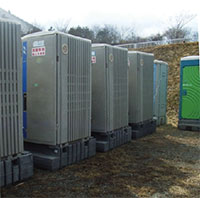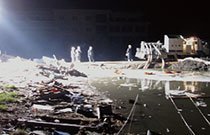Satellite communication technology saved the area from losing all contact. It became the hotline of the whole prefecture and its many cities and villages. The disaster areas were immediately provided with everything requested, from diapers and bedding to fuel, washing machines and even temporary housing. The website of the regional bureau has become a temporal bulletin board for cities and villages to communicate their requests. Everything was done to support the disaster victims to the fullest.
Support disaster-affected people and area.
Record of support towards the disaster-affected area and victims
Relief supplies were sent to 31 municipalities in four prefectures.
The dispatched liaisons support prefectural and municipal functions.
The MLIT staffs were dispatched to the affected prefectures or municipalities, and worked as coordinators in the prefectural or municipal office.
They were called liaisons (on-site information coordinator for disaster response). Liaisons coordinated with various support organizations, according to the needs of the municipalities they understood. Liaisons are good at coordination between the prefectural and state organizations, and familiar with the relevant laws. They sometimes worked as local staffs on behalf of the municipal staffs who were completely occupied with disaster responses, and at other times as important and trusted partners of the municipal leaders. The liaisons were sent to 31 municipalities in 4 prefectures. The number of liaisons sent was 96 on March 23 at its peak. Total number of liaisons reached 3,916 by June 30, counted after the occurrence of the disaster.

Source: the MLIT Tohoku Regional Bureau

(Pumper truck rainage plan meeting) Higashimatsushima

The liaison from the Tohoku Regional Bureau
Providing communication equipment to the affected municipalities.

Source: the MLIT Tohoku Regional Bureau
Satellite communication vehicles substituted for completely cut communication systems of the affected municipalities.
The communication system, a lifeline for the disaster-affected people, had been completely disrupted. Some municipalities, having had damage to their municipal office, such as Minamisanriku in Miyagi Prefecture, even lost their administrative function.
From the second day following the disaster, the MLIT began mobilizing the disaster response vehicles called in from the Regional Bureaus all over Japan, and sent them to 16 municipalities by the fourth day. 192 disaster response vehicles were mobilized on April 15 at the peak. The vehicles secured the communication system connecting with all the affected municipalities, allowing their voices to be heard: for instance, about the magnitude of damage in details, what kind of relief supplies they really needed, etc. This eventually led to increasing support to the disaster-affected people.
Dealer of black market

Procurement went beyond the jurisdiction of the MLIT
A letter from the Tohoku Regional Bureau chief was handed over to the leaders of the affected municipalities by dispatched liaisons (on-site coordinator for disaster response). “Consider me a dealer of black market, and tell us anything you need”, said the letter. Although the “willingness to extend any kind of support even beyond the jurisdiction of the MLIT” was expressed in the previous message, most of the municipal leaders were hesitant about asking what was offered. That was why the message was so phrased, in an expression rarely used in official letters, to let the municipality leaders know that the message was indeed what it meant.
After this message, many municipality leaders indeed started contacting the Bureau for a variety of requests. The exceptional procurement began.
Things ranging from temporary housing, portable toilets, fuels, etc. to sanitary items and coffins were procured.
Example of relief supplies (As of March 31)



| Item | Total amount | Number demanded | Number supplied |
|---|---|---|---|
| Temporary buildings | 300 | 12 | 8 |
| Carpet | 1,951㎡ | 2 | 0 |
| Insulating material | 6,990㎡ | 2 | 0 |
| Portable toilets | 1,039 | 11 | 11 |
| Tents | 576 | 7 | 4 |
| Coffins | 100 | 1 | 1 |
| Storage bags | 883 | 2 | 2 |
| Gasoline | 11,000L | 4 | 4 |
| Gas oil | 36,740L | 17 | 17 |
| Kerosene | 56,400L | 8 | 8 |
| Engine generators | 95 | 9 | 9 |
| Communication facility | 1 | 1 | 1 |
| Installation of satellite phone | 1set | 1 | 1 |
| Backhoes | 6 | 2 | 2 |
| Bottled water/tea | 31,900 | 8 | 8 |
| Daily necessities, food etc. | 1set | 22 | 22 |
| Sanitary napkins | 300 | 1 | 1 |
| Diapers (for child/adult) | 500 sets | 1 | 1 |
| Futons | 300 sets | 1 | 1 |
| Washing machines | 30 | 2 | 2 |
| ・ ・ ・ |
|||
| Total | 218 | 198 | |
Response to requests after 3/13 (as of 31st of March)
- Request fulfillment rate 91%(=198/218)
- Average response time 2.93 days
Transmit to the whole country via affected municipality SOS website.
The space of the Bureau’s website was made available for the affected municipalities which lost a means of communication.

Disaster-stricken municipalities lost a means of effective communication. They must be having a hard time due to shortage of necessary goods - the MLIT Tohoku Regional Bureau made a “Temporary Bulletin Board for the Affected Municipalities“ on the Bureau’s website, until a full-scale communication means was restored in the municipalities. The bulletin was used by 20 municipalities as a space to make necessary announcements, for example, about their needs for relief supplies, etc. Urgent needs announced on this bulletin brought about the flow of relief supplies from all over Japan.
To assist the search of survivors the emergency drainage was performed on 24 hour a day basis.
To assist the search of missing persons 120 pumper trucks were dispatched.

Tsunami flooded various locations in Iwate, Miyagi and Fukushima prefectures. Immediate drainage was necessary to proceed with the search of missing persons. In response to this MLIT gathered 120 disaster response vehicles from all over the country including the illumination trucks. All of them were dispatched as per requests from local municipalities via the liaison (on-site information coordinator for disaster response) immediately. The emergency drainage was performed on 24 hour a day basis.

Source: the MLIT Tohoku Regional Bureau

Source: the MLIT Tohoku Regional Bureau

Drainage was performed on 24 hour a day basis
Source: the MLIT Tohoku Regional Bureau
